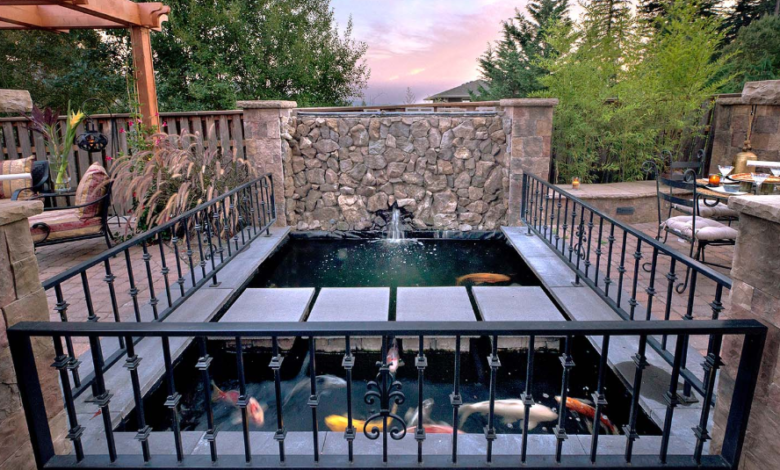Design Inspiration: How to Landscape Around a Koi Pond

When it comes to koi pond building, many pond owners focus on the technical aspects, such as excavation, liners, pumps, and filtration systems. While these elements are crucial for maintaining clean water and ensuring the health of your koi, landscaping is often overlooked. However, landscaping plays an equally important role in the success of your pond. It enhances both the aesthetic appeal and functionality of the area surrounding your pond, turning it into a tranquil and beautiful backyard retreat. In this article, we’ll explore how to landscape around your koi pond, adding value to your koi pond building project.
Why Landscaping is Essential in Koi Pond Building
Landscaping serves several vital functions when it comes to koi pond building. A well-thought-out design doesn’t just enhance the visual appeal of your pond; it also improves its ecosystem and makes it easier to maintain. Here are some key reasons why landscaping is so important:
- Improved Water Quality: Proper landscaping can reduce runoff and erosion, which helps keep the water in your pond clean and clear.
- Temperature Control: Plants and trees can provide shade, helping regulate the temperature of the water and prevent algae blooms.
- Safety: Landscaping features like rocks or fencing can create safe barriers, preventing children, pets, or wildlife from falling into the pond.
- Ease of Maintenance: Thoughtfully placed plants and structures make feeding koi and maintaining the pond much easier.
In short, landscaping is an essential element that ties the koi pond building process together, providing both beauty and function.
Choosing the Right Plants for Koi Pond Landscaping
Plants are an important part of your koi pond building project. Not only do they enhance the natural look of the pond, but they also support the pond’s ecosystem by offering shade and oxygen, both of which are crucial for koi health. Here are some types of plants to consider:
Aquatic Plants
Aquatic plants like water lilies, lotus, and water hyacinths provide shade to the pond, reduce algae growth, and oxygenate the water, which is vital for your koi.
Marginal Plants
Marginal plants, such as cattails, irises, and pickerelweed, grow along the pond’s edges and help filter impurities from the water. These plants also create a soft, natural transition between the pond and the surrounding garden.
Border and Ground Cover Plants
Plants like creeping thyme, moss, and ferns can be used around the edges of the pond to prevent soil erosion and enhance the natural appearance. They also make the pond feel integrated with the rest of your garden.
Incorporating a variety of plant types into your koi pond building project ensures a balanced ecosystem, benefiting both the aesthetic appeal and the health of your koi.
Incorporating Rocks and Hardscaping in Koi Pond Building
Rocks and stonework are integral components of koi pond building. Not only do they add a natural, rugged look to your pond, but they also help with pond structure and maintenance. Here are some ways to use rocks effectively:
Boulders and Large Stones
Large stones can be used to frame the pond, creating a natural boundary while also providing hiding spots for koi.
Flat Stones
Flat stones can form paths or stepping stones around the pond, making it easier to access and maintain.
Gravel and Pebbles
Gravel can be used around the pond’s edges and in the shallows to help with erosion control and to enhance the overall appearance of your pond.
Rocks are not just decorative; they’re a practical addition to any koi pond building project, improving durability and ease of maintenance.
See also: Effortless Elegance: The Perfect LED TV Stand for Your Home
Adding Functional Features to Your Koi Pond
In addition to plants and rocks, functional features can enhance your koi pond’s usability and comfort. Consider incorporating the following elements into your koi pond building project:
- Seating Areas: Place benches or stone seating around your pond to create a comfortable space where you can relax and enjoy watching your koi.
- Lighting: Subtle garden lights or underwater LED lights can highlight the pond’s beauty and create a serene atmosphere at night.
- Pathways: Gravel or stone pathways provide easy access for feeding koi and maintaining the pond without disturbing the landscaping.
- Waterfalls or Streams: These not only improve water circulation and oxygenation but also add visual interest and soothing sounds to your pond area.
These functional features will elevate your koi pond building project, turning your pond into a place of beauty, relaxation, and ease of care.
Balancing Beauty and Fish Safety in Koi Pond Building
While landscaping is important for the visual appeal of your koi pond, the safety of your koi should always be the top priority. Some plants and materials can negatively impact water quality or harm your koi. Here are a few things to keep in mind during the koi pond building process:
- Choose Safe Materials: Avoid sharp-edged rocks or chemically treated wood that could harm your koi or pollute the water.
- Provide Shade: Ensure that your pond has shaded areas, either from plants or structures like pergolas, to protect your koi from direct sunlight and keep water temperatures stable.
By considering the safety and well-being of your koi during the landscaping process, you can create a beautiful yet functional pond that supports both the fish and the ecosystem.
Seasonal Landscaping Considerations for Your Koi Pond
Landscaping around your koi pond should be designed with seasonal changes in mind. Each season brings different challenges and opportunities for pond care. Here’s how to handle landscaping throughout the year:
- Spring: This is the ideal time for planting new vegetation and allowing it to establish roots for a healthy ecosystem.
- Summer: Maintain shade and trim back plants to prevent algae overgrowth and maintain water quality.
- Autumn: Clear fallen leaves and other debris regularly to avoid decaying organic matter from affecting the pond’s water.
- Winter: Consider adding hardy evergreens or rocks to keep the pond looking attractive during the colder months when other plants die back.
By keeping the seasonal needs of your pond and landscaping in mind, you’ll ensure that your koi pond building project remains vibrant and healthy all year long.
Common Mistakes to Avoid in Koi Pond Landscaping
Despite careful planning, many koi pond owners make mistakes when landscaping around their ponds. Avoiding these common mistakes can help ensure the long-term success of your koi pond building:
- Planting Too Close to the Pond: Placing plants too near the water’s edge can result in debris falling into the pond, which can lead to algae growth and water quality issues.
- Using Sharp or Unstable Rocks: Sharp stones can injure koi, while unstable rocks can damage pond liners or cause hazards.
- Overcrowding with Plants: Too many plants around the pond can block access and complicate maintenance. Make sure to balance vegetation with open spaces.
- Neglecting Pathways: Without defined walkways, the ground around your pond can become muddy and uneven. Adding paths will make it easier to maintain and enjoy your pond.
- Forgetting About Shade: Direct sunlight can cause water temperature fluctuations and encourage algae growth. Add shade elements to protect your koi and regulate the water temperature.
Avoiding these mistakes will ensure your koi pond building project remains safe, low-maintenance, and visually stunning.
FAQs on Koi Pond Building and Landscaping
What should I consider when starting koi pond building?
When starting your koi pond building, consider pond size, filtration systems, water flow, and how you want to incorporate landscaping. Planning is essential for long-term success.
How do I maintain landscaping around my koi pond?
Regular pruning, seasonal plant care, and cleaning debris from the pond are key. Additionally, choosing hardy plants can reduce maintenance.
Can I build a koi pond without landscaping?
While it’s possible to build a functional pond without landscaping, adding plants, rocks, and other features enhances both the beauty and health of your koi pond.
How much space should I leave for landscaping around the koi pond?
You should leave at least 2–3 feet of clear space around the pond’s edge to allow for plants, rocks, and pathways.
How do I keep my koi pond healthy year-round?
Maintain your koi pond’s health by managing water quality, ensuring shade in hot months, and clearing debris in the fall. Seasonal landscaping care also helps maintain its appeal and functionality.
Conclusion
Landscaping plays a critical role in koi pond building, turning your pond from a simple water feature into a stunning focal point of your backyard. By choosing the right plants, rocks, and functional features, you can create a pond that’s not only beautiful but also healthy and easy to maintain. Thoughtful landscaping ensures your koi pond is a place of tranquility and enjoyment, supporting the health of your koi and enhancing the overall beauty of your garden for years to come.
